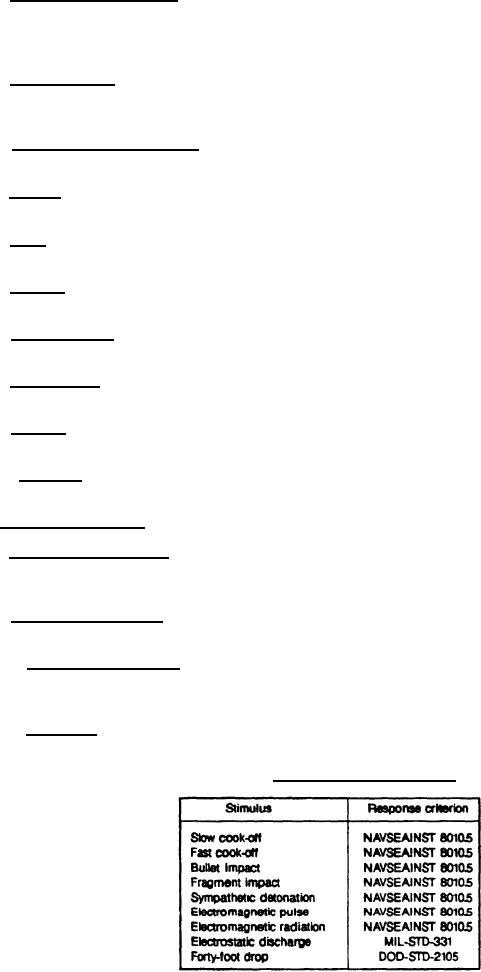 |
|||
|
Page Title:
Table V. Igniter sensitivity to stimuli. |
|
||
| ||||||||||
|
|  MIL-I-85889(AS)
3.4.1 Transporation vibration. When in its shipping condition (see 6.3.1.1), the igniter shall be capable of
withstanding the vibration environment resulting from land, sea, or air transport. The maximum expected
transportation distance is 3000 miles, and the packaged igniter or rocket motor is expected to be treated as secured
cargo (see 45.2.1).
3.4.2 Thermal shock. When in its bare condition (see 631.3), the igniter shall be capable of withstanding the
thermally induced stresses resulting from transfer between the extreme temperature environments of its life cycle
(see 45.2.2).
3.4.3 High temperature storage. When in its bare condition (see 6.3.1.3), the igniter shall be capable of
withstanding prolonged storage at the storage temperature upper limit (see 45.2 S).
3.4.4 Altitude. When in its shipping condition (see 631.1), the igniier shall be capable of withstanding the reduced
pressure environment resulting from transport in a cargo airplane (see 45.2.4).
3.4.5 Rain. A Type II igniter in the bare condition (see 6.31.3) shall be capable of withstanding the blowing rain
environment typical of a high intensity storm (see 45.25).
3.4.6 Salt fog. A Type II igniter in the bare condition (see 6.3.1.3) shall be capable of withstanding the aqueous
salt atmosphere typical of coastal regions (see 45.2.6).
3.4.7 Sand and dust. A Type II igniter in the bare condition (see 6.3.1.3) shall be capable of withstanding the
airborne dust environment associated with hot, dry regions of the earth (see 4.5.2.7).
3.4.8 Six-foot drop. When in its bare condition (see 6.3.1.3), the igniter shall be capable of withstanding a drop
of six feet onto a hard surface as typical of a handling mishap (see 45.2.6).
3.4.9 Fungus. When in its bare condition (see 6.3.1.3), the igniter shall withstand the attack of fungi typical od
humid tropical regions of the earth (see 452.9).
3.4.10 Humidity. A Type II igniter m me bare condition (see 6.3.1.3) shall be capable of withstanding the moist
environment typical of warm, humid regions of the earth (see 4.5.2.10).
3.5 Other requirements.
3.5.1 System safety program. The contractor shall conduct a system safety program in accordance with Task
100 of MIL-STD-882. AS a design goal, all Category I and II hazards shall be eliminated. As a minimum, the probability
of occurrence of Category I and II hazards shall be remote.
3.5.2 Hazard characteristics. The igniter shall be designed to pose minimum hazard consistent with its intended
use.
3.5.2.1 Hazard classification. The igniter shall be designed so that its responses to the tests defined by
NAVSEAINST 80208 are such that it qualities for a DOD hazard class/division no more severe than 1.3 and a shipping
classification no more severe than Class B (see 4.4.2.2).
3.5.2.2 Sensitivity. The igniter shall be designed such that it exhibits acceptable sensitivity to the stimuli in
table V.
TABLE V. Igniter sensitivity to stimuli.
9
|
|
Privacy Statement - Press Release - Copyright Information. - Contact Us |